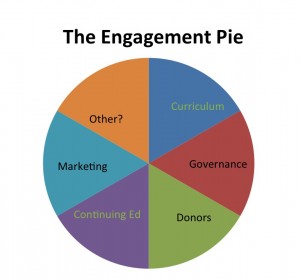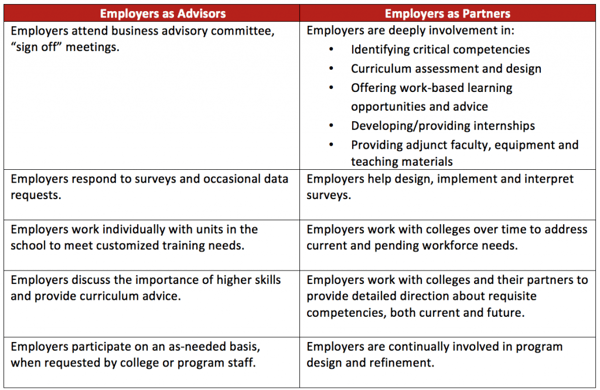Published on
What about Employer Engagement? Higher Education’s New Frontier

Lately we’ve received many requests for help around the issue of employer engagement. The requests are coming from both community colleges and baccalaureate institutions that want to create more robust and effective partnerships with their local communities. All in all, this is very good news.
What is Employer Engagement?
College connections to employers are not new. Customized programs, employer advisory councils and employer-college partnerships have been around for a long time. All too often, however, these relationships are “spotty” within an institution, meaning they’re found in certain pockets but not others — in continuing education, in technical education programs or within business schools that might occasionally assemble an advisory committee to review and “bless” a curriculum.
Employer engagement can and should be so much more. In the most effective employer-college partnerships, employers and colleges view each other as strategic partners. Within any given institution, effective employer engagement is:
- Organization-wide
- Mutual
- Ongoing
Why Employer Engagement?
It has been well publicized that the United States is facing a skills crisis.
- In “Recovery: Job Growth and Education Requirements through 2020,” the Center on Education and the Workforce at Georgetown University reports that, “At the current production rate in higher education, we will fall five million short of the workers with postsecondary credentials we will need by 2020.” (June 2013)
- The Manpower Economist Intelligence Unit warns that “by 2020 there will be 123 million high-skill, high-pay jobs available in the United States, but only 50 million Americans with the right education to fill them.” (From a 2012 survey)
Colleges have geared up to address the crisis, but it’s obvious they can’t and won’t be successful in a vacuum. To effectively tackle the credential gap, colleges need to have effective, ongoing employer partnerships in place. Philanthropic foundations and the federal government have also gotten this message and have increased the pressure on colleges to expand their partnerships to include employers and workforce boards, as well as regional economic development organizations.
Checking Perceptions
There’s often a mismatch between the perceptions of colleges and the perceptions of employers about how prepared students are to enter the workforce. For example:
- A Bersin & Associates study published in the March 22, 2013 issue of Chief Learning Officer Magazine reported that 72 percent of educational leaders think newly-educated workers are ready for work, while only 42 percent of employers think so.
- The February 26, 2014 issue of the Chronicle of Higher Education reported the results of a 2014 Gallup-Lumina poll that found 96 percent of college and university chief academic officers were confident in their ability to prepare students for workforce success, but only 11 percent of business leaders agreed that today’s graduates have the skills and competencies their businesses need.
These results should be a wake-up call for every person connected with a college or university.

We often find pockets within a college with robust employer partnerships, for example, around technical curriculum development. Nearly all colleges interact with employers on a number of fronts, but too often these connections occur in silos and are not connected or cohesive. To get an accurate picture, colleges should first develop a comprehensive scan of their employer connections. The overriding questions are: Where are our connections with employers? For what reasons? And with what results?
Employers as Advisors — Employers as Partners
The most successful and effective college-employer partnerships are organization wide, mutual and ongoing. In other words, the relationship has moved from one of employers-as-advisors (with deep pockets) to one of a true partnership. While there are many variations on the advisor-partnership dichotomy, in rough fashion, this is what we’re seeing:
Effective employer partnerships are not easy or quick. But neither is a reason not to get started. The stakes are high and the rewards for students, colleges, communities and the country are definitely worth it.
Author Perspective: Association




